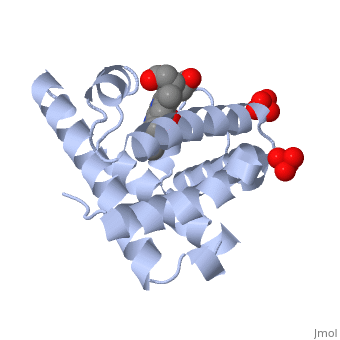1a6m
From Proteopedia
OXY-MYOGLOBIN, ATOMIC RESOLUTION
Structural highlights
FunctionMYG_PHYMC Serves as a reserve supply of oxygen and facilitates the movement of oxygen within muscles. Evolutionary ConservationCheck, as determined by ConSurfDB. You may read the explanation of the method and the full data available from ConSurf. Publication Abstract from PubMedWe have used x-ray crystallography to determine the structures of sperm whale myoglobin (Mb) in four different ligation states (unligated, ferric aquomet, oxygenated, and carbonmonoxygenated) to a resolution of better than 1.2 A. Data collection and analysis were performed in as much the same way as possible to reduce model bias in differences between structures. The structural differences among the ligation states are much smaller than previously estimated, with differences of <0.25 A root-mean-square deviation among all atoms. One structural parameter previously thought to vary among the ligation states, the proximal histidine (His-93) azimuthal angle, is nearly identical in all the ferrous complexes, although the tilt of the proximal histidine is different in the unligated form. There are significant differences, however, in the heme geometry, in the position of the heme in the pocket, and in the distal histidine (His-64) conformations. In the CO complex the majority conformation of ligand is at an angle of 18 +/- 3 degrees with respect to the heme plane, with a geometry similar to that seen in encumbered model compounds; this angle is significantly smaller than reported previously by crystallographic studies on monoclinic Mb crystals, but still significantly larger than observed by photoselection. The distal histidine in unligated Mb and in the dioxygenated complex is best described as having two conformations. Two similar conformations are observed in MbCO, in addition to another conformation that has been seen previously in low-pH structures where His-64 is doubly protonated. We suggest that these conformations of the distal histidine correspond to the different conformational substates of MbCO and MbO(2) seen in vibrational spectra. Full-matrix refinement provides uncertainty estimates of important structural parameters. Anisotropic refinement yields information about correlated disorder of atoms; we find that the proximal (F) helix and heme move approximately as rigid bodies, but that the distal (E) helix does not. Crystal structures of myoglobin-ligand complexes at near-atomic resolution.,Vojtechovsky J, Chu K, Berendzen J, Sweet RM, Schlichting I Biophys J. 1999 Oct;77(4):2153-74. PMID:10512835[1] From MEDLINE®/PubMed®, a database of the U.S. National Library of Medicine. See AlsoReferences
| ||||||||||||||||||||


